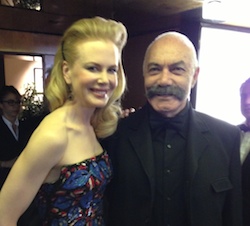By Jeff Farr
Juan Carlos Cremata Malberti’s “Viva Cuba!” (2005) is a great reminder of how much potential the Cuban cinema is storing up. This is one of the few Cuban films in recent years to have received international attention on the festival circuit–winning the Grand Prix at Cannes Film Fest for children’s cinema–but we are sure to see more noteworthy films from Cuba soon.
“Viva Cuba!” is at once heir to the kind of children’s art film that Francois Truffaut specialized in and perfected and the traditional Hollywood road movie. The film begins in Havana with two fifth graders, Jorgito (Jorge Milo) and Malu (Malu Tarrau Broche), enjoying an unusually close bond — despite the animosity between their respective mothers — that will soon lead them into a life-changing adventure far from the safety of home.
With few false notes, Malberti begins by capturing the joyous neighborhood playtime of Jorgito, Malu, and friends. It is clear from the opening minutes that this story will be told from the children’s perspective, not any kind of political treatise on the state of Cuba. Staying true to the kids’ point of view, it seems natural that Cuban politics take a backseat for Malberti. Jorgito and Malu have little understanding — and perhaps more importantly little time — for the political world of grown-ups.
For adult viewers, however, some of the most revealing scenes take a peek into the little-seen Cuban schooling system, where the children, in colorful uniforms, learn Communist ideals and to revere Cuban national heroes like Che Guevara andJosé Martí. The regimented, idealistic, and, yes, political world of school serves as a contrast to some of the chaos Jorgito and Malu experience at home and in their neighborhood.
“Viva Cuba!” probably would be a stronger film if Malberti had connected more political dots. He certainly could have done so without overdoing it. How are the children processing the education they are receiving? Hearing them talk about it, even a little, would have added more value to the film. But perhaps Malberti’s point is that they are not processing their education whatsoever; it is all words to them, irrelevant to their lives, just like all the other things their parents tell them to do.
Malberti gets great performances from his child actors, namely Milo and Broche, who carry much of the film on their own. Their enthusiasm and spontaneity fill this fast-paced film with life. The two seem to be having fun every minute of their time onscreen together, even when their characters are not getting along too well.
The plot kicks in when Malu’s beloved grandmother dies. The girl overhears her mother’s plans to leave the country now that she no longer needs to care for the grandmother. In fact, her mother will marry a foreigner, taking Malu along with her. The intended destination is never identified, which is perhaps Malberti’s way of emphasizing how for the children there is only Cuba and the “foreign” — the rest of the world, which remains vague and unknowable to them. In one of the film’s best-written scenes, Jorgito asks Malu if she will also become a “foreigner” if she is forced to follow her mother. There is a sense of Cuba’s isolation always at work in this film, although it comes to the surface in only a couple of moments like this one. The overall sense is of a beautiful country, strangely cut off from the world.
Before she can leave Cuba, Malu’s mother must get the girl’s estranged father to sign an “exit authorization” for their daughter. Jorgito, trying to encourage Malu out of her despair, hatches the idea for their road trip: The two will travel across Cuba to find Malu’s father, at the remote lighthouse where he works in Maisí, and convince him not to sign the authorization. They must get there before Malu’s mother’s request arrives.
The children’s trek, which highlights many of the natural wonders of the island, is intercut with their mothers’ emotional reactions to their disappearance and the authorities’ rather slow efforts to track them down. Luisa María Jiménez Rodríquez and Larisa Vega Alamar bring in a lot of humor as the hysterical mothers, whose long-held animosity toward each other predictably starts to melt away, becoming a new friendship, as the search for the children continues.
Jorgito and Malu, meanwhile, have a falling out, as the stressful journey starts to take its toll on their young psyches. A camper they meet in the mountains urges them to bury the hatchet as they reach the final leg of their odyssey. The life lesson here feels a bit tired — and the children’s breakup and reconciliation a bit too manufactured — but the young actors nevertheless convey this sense of a deep bond that makes the drama work.
“Viva Cuba!” ends on an enigmatic note, which recalls the famous final freeze-frame of Truffaut’s “400 Blows” (1959). Once again, we have children rejecting adult ways but seeming to have nowhere else to turn — except to the sea. Although this may be an ending we have seen before, Malberti does avoid the happy ending.
This helps to offset some earlier sequences that may push the “cute envelope” a bit too far. In particular, a scene in which Jorgito and Malu sleep on the beach and watch in awe as poorly animated stars shoot across the sky is nothing but annoying. There is also an unfortunate subplot involving the mythical Güije, a black midget who terrorizes people, which many viewers may find to be tinged with racism.










